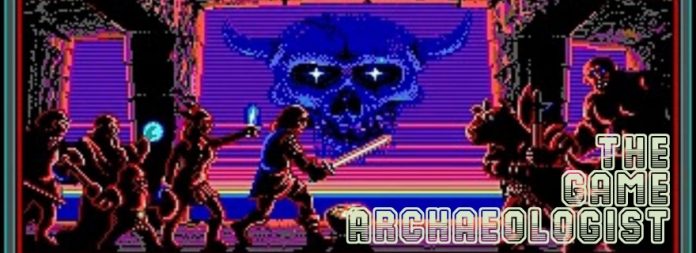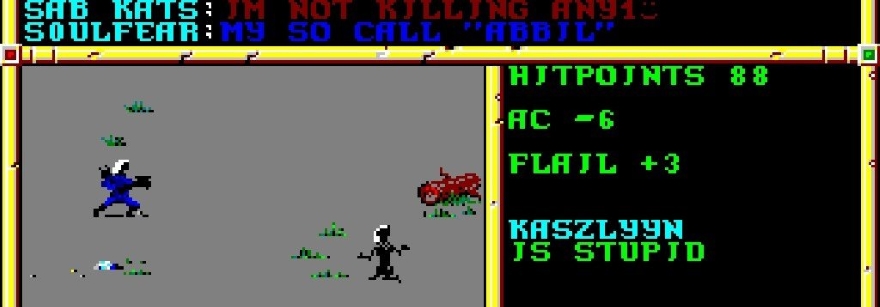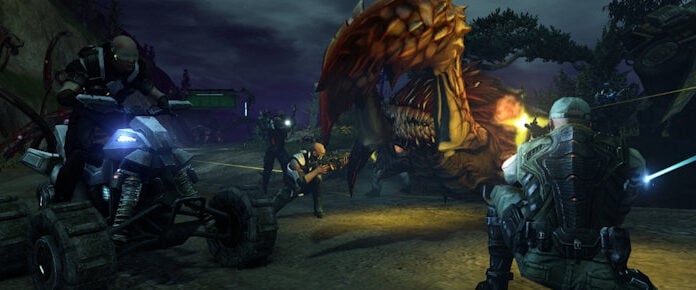
Here’s a question for you: How much do you really, really have to love a game to pay $6 to $8 an hour to play it? Considering how much we tend to whine about a flat $15/month fee, I’m guessing the answer is, “Only if it made me romantically irresistable and regularly supplied chocolate milkshakes.”
And yet, in 1991 this wasn’t considered a crazy extortionist practice; it was dubbed “being a pioneer.” While online RPGs were nothing new by then, few had tackled the jump from text to graphical games due to the technological limitations, questions over a potential market, and the required funding. It took the efforts of a Superfriends-style team to make this happen with Neverwinter Nights: Stormfront Studios developed the game, TSR provided the Dungeons & Dragons license, SSI published it, and AOL handled the online operations.
And thus six years before Ultima Online and 13 before World of Warcraft came on the scene, what many consider the first true multiplayer graphical RPG went online and helped forge a path that would lead to where we are today. With only a few hundred players per server, Neverwinter Nights may not have been “massively,” but it deserves a spot of honor as one of the key ancestors to the modern MMO.
Gold Box fever
Veteran CRPG enthusiasts probably remember SSI’s Gold Box series fondly (and also with the troubling thought of “Holy crud, am I that old?”). The Gold Box engine provided a robust experience while allowing developers to churn out adventures far more quickly than creating new engines from scratch for each one. From 1988 through 1993, Gold Box RPGs (so-called for their distinctive gold packaging) gave computer RPGs a sizable boost in credibility and sales.
Thus, when Stormfront made Neverwinter Nights, the studio enjoyed the benefit of the game joining such esteemed company as Pool of Radiance (which it also developed) and Buck Rogers: Countdown to Doomsday. Even though the Gold Box engine was never designed for online functionality in mind, the Stormfront team recognized the potential for such play and made Neverwinter Nights in 18 months, start to finish.
Lead Developer Don Daglow said that major influences for the creation of Neverwinter Nights were the online graphical capabilities of 1987’s Air Warrior: “I thought to myself, ‘If the guys at Kesmai can figure out how to get those graphics up online, we can figure out how to tell stories with characters and maps, not just text.'”
With the established trust that came with the Gold Box label and the promise of cross-overs between titles, gamers had an easier time making the leap to the wild world of online play. For many folks, this was their first taste of gaming online, and the novelty of it — meeting other players, forming guilds, enjoying a persistent world, building up a character — proved instantly addicting.
 Munchkin land
Munchkin land
Set in the ever-popular Forgotten Realms campaign, Neverwinter Nights invited players to explore an environmentally diverse region, collect sparkly loot, and increase their characters’ power and skills. While it certainly was not as full-featured as later MMOs, NWN had dungeon crawls, guilds, user chat, PvP, and other basic staples of the genre.
Because the game was a Dungeons & Dragons title, players encountered the familiar trappings of the pen-and-paper game, including the nine alignments (such as true neutral or chaotic evil), six races (Dwarves, Elves, Gnomes, Half-Elves, Halflings, and Humans), and six classes (Clerics, Fighters, Rangers, Paladins, Magic-Users, and Thieves). Players could even dual-class once they advanced far enough in the game.
Players explored the lands of Neverwinter using a first-person mode (which were supplemented with maps and stills) but fought in a top-down strategic map.
When it kicked off, NWN existed on a single server that was capable of hosting 200 players or less, but this was enough to get the train going. Before long, new servers were added and the game quickly became one of the most popular features on AOL’s service. By the time NWN hit version 2.2, the servers could hold 500 a pop — a ten-fold increase since launch — and often had a queue of players waiting for a spot to open.
Despite its popularity, the MMO only received two major updates in its run. “We were anxious to expand and enhance Neverwinter Nights, since it was by far their biggest hit game,” Daglow said. However, AOL was too busy with the rest of its service to give the team the go-ahead for greater development.
Socialization was a huge factor in NWN’s appeal. Players began to organize in-game events, such as summer festivals, trivia nights, and PvP ladders. AOL’s Steve Case would even often play alongside customers as his alter ego “Lord Nasher.” If a player had a lot of experience in the game and a good name among the community, he or she could even apply to become a special guide, tasked with helping out newbies and the lost.
 A decade of dominance
A decade of dominance
Neverwinter Nights enjoyed one key advantage that kept it in the dominating spot for the bulk of the ’90s: a near and almost-total lack of competition. From 1991 until the middle of the decade, Neverwinter Nights was pretty much the only major MMO provider (and I used the word “major” very loosely here) — this just wasn’t a genre that studios were champing at the bit to enter. As a result, NWN enjoyed the top spot for several years, only to hand off the baton to Ultima Online.
Over the lifespan of Neverwinter Nights, the hourly charge decreased as the players immigrated to the servers. In fact, after 1996 AOL simply charged a flat monthly rate instead of per hour. Modems became faster during the ’90s, the world wide web became a household fixture, and online gaming began to make inroads with a wider base of players. Neverwinter Nights could have grown into something even bigger.
Although the Neverwinter Nights was reportedly earning AOL “millions,” a dispute between AOL, SSI, and TSR over its business direction triggered an aburpt shutdown on July 18th, 1997, devastating the playerbase. “The Games Channel has abiding affection for Neverwinter Nights, one of our oldest games. We understand that this is disappointing news to our many Neverwinter players, and we regret any unhappiness that this causes you,” AOL posted.
Stormfront Studios continued on until 2008, mainly focusing on console game development. The team never returned to the realm of online games, which Daglow found disappointing.
By the end of its run, NWN boasted a tally of 115,000 players who had stepped foot in the game at one point or another. Interestingly enough, ambitious players reverse-engineered the MMO version using the Forgotten Realms Unlimited Adventures kit to make a single-player Neverwinter Nights that can be enjoyed today.
 Legacy
Legacy
One of the main questions that I like to ask in The Game Archaeologist is, “What did this MMO leave behind as its legacy?” On one hand, Neverwinter Nights certainly didn’t become a smash hit, advance past a strict 2-D format, or provide a great amount of user friendliness. However, it helped the industry take a major step forward into the graphical realm even as it used a jury-rigged game engine to do so.
Neverwinter Nights also kick-started an interesting if scattered franchise. BioWare snapped up the rights to make Neverwinter Nights in 2002, Obsidian Entertainment handled the sequel in 2006, and most recently, Cryptic Studios secured the IP to produce Neverwinter. Interestingly enough, the old AOL community came back in BioWare’s game to re-create some favorite stomping lands from the now-canceled title.
Even though 1991 is in the ancient past when it comes to computer games, Neverwinter Nights was nevertheless given a special award at the 2008 Annual Technology & Engineering Emmy Awards for “Advancing the Art Form of MMORPG Games” — an honor that it now shares with EverQuest and World of Warcraft.
Neverwinter Nights Lead Designer Don Daglow accepted the award with these words: “These games are not just entertainment. They build new kinds of communities and create deep people-to-people relationships. They influence people’s lives in the same way as great books, inspiring movies and iconic television shows.”
I don’t think I could’ve put it better.
 Believe it or not, MMOs did exist prior to World of Warcraft! Every two weeks, The Game Archaeologist looks back at classic online games and their history to learn a thing or two about where the industry came from… and where it might be heading.
Believe it or not, MMOs did exist prior to World of Warcraft! Every two weeks, The Game Archaeologist looks back at classic online games and their history to learn a thing or two about where the industry came from… and where it might be heading.















